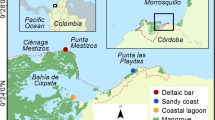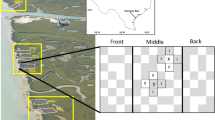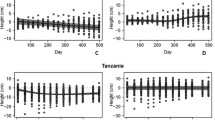Abstract
Research on erosion control with vegetation by the Coastal Engineering Research Center (CERC) demonstrated that salt marsh plantings help dissipate wave energy causing deposition of sediments. These processes can convert eroding environments into depositional environments producing shore advancement. To evaluate the impact of shoreline plantings in oligohaline coastal environments, a 30 meter segment of a planting was monitored over an eight-year period. Within five years, erosion ceased, and at least 20 additional species of plants had invaded the study site.
Similar content being viewed by others
Literature Cited
Birkemeier, W. A., A. E. DeWall, C. S. Gorbics, and H. C. Miller, 1981. A user’s guide to CERC Field Research Facility, MR-81-7, U. S. Army, Corps of Engineers, Coastal Engineering Research Center, Fort Belvoir, VA.
Dean, R. E., 1978. Effects of vegetation on shoreline erosional processes. Pages 415–426 in Wetland Functions and Values: The state of our understanding, Proceeding of the National Symposium on Wetlands.
Diaz, R., 1982. Personal Communication. College of William and Mary, Virginia Institute of Marine Science, School of Marine Science, Gloucester Point, VA.
Dodd, J. D. and J. W. Webb. 1975. Establishment of vegetation for shoreline stabilization in Galveston Bay. MP 6-75, U.S. Army, Corps of Engineers, Coastal Engineering Research Center, Fort Belvoir, VA.
Fleming, M. V. and A. E. DeWall, 1982. Beach profile analysis system. Vol. 1–8. U.S. Army Coastal Engineering Research Center, Kingman Building, Fort Belvoir, VA. In press.
Garbisch, E. W., Jr., P. B. Woller, and R. J. McCallum, 1975. Salt marsh establishment and development. TM-52, U.S. Army, Corps of Engineers, Coastal Engineering Research Center, Fort Belvoir, VA.
Gleason, M. L., D. A. Elmer, N. C. Pien, and J. S. Fisher, 1979. Effects of stem density upon sediment retention by salt marsh cordgrass,Spartina alterniflora Loisel. Estuaries, Journal of Estuarine Research Federation. Vol. 2 No. 4, December.
Knutson, P. L., 1976. Development of intertidal marshlands upon dredged material in San Francisco Bay. Proc. of Seventh World Dredging Conf. San Francisco, CA 103–118.
Knutson, P. L., J. C. Ford and M. R. Inskeep., 1981. National Survey of planted salt marsh (vegetative stabilization and wave stress). J. of Society of Wetland Scientists. Sept. 129–157.
Knutson, P. L., R. A. Brochu, W. N. Seelig, and M. R. Inskeep, 1982. Wave damping inSpartina alterniflora marshes. J. of Society of Wetland Scientists. (In Press).
Miller, H. C., 1982. Personal communications. U.S. Army Corps of Engineers, Coastal Engineering Research Center, Field Research Facility, Duck, N. C.
Newcombe, C. L., J. H. Morris, P. L. Knutson and C. S. Gorbics., 1979. Bank erosion control with vegetation. San Francisco Bay, California. MR 79-2, U.S. Army, Corps of Engineers, Coastal Engineering Research Center, Fort Belvoir, VA.
Phillips, W. A. and F. D. Eastman., 1959. Riverbank stabilization in Virginia. J. of Soil and Water Cons. 14: 257–259.
Sharp, W. C. and J. Vaden, 1970. Ten-year report on sloping techniques used to stabilize eroding tidal river banks, Shore and Beach. 28 31–35.
Shoreline Erosion Control Demonstration Program. 1981. Coastal Engineering Research Center, Unpublished data. Section 54 of Public Law 93–251, 93rd Congress.
Wayne, C. J., 1975. Sea and Marsh grasses: Their effect on wave energy and nearshore transport. Tallahassee, Florida State University, Thesis (M.S.).
Webb, J. W. and J. D. Dodd, 1976. Vegetative establishment and shoreline stabilization, Galveston Bay, Texas. TP 76-13, U.S. Army, Corps of Engineers, Coastal Engineering Research Center, Fort Belvoir, VA.
Woodhouse, W. W., Jr., E. D. Seneca and S. W. Broome, 1972. Marsh building with dredge spoil in North Carolina. Bulletin 445, Agriculture Experiment Station, North Carolina State University, Raleigh, NC.
Woodhouse, W. W., Jr., E. D. Seneca and S. E. Broome. 1974. Propagation ofSpartina alterniflora for substrate stabilization and salt marsh development. TM-46. U.S. Army, Corps of Engineers, Coastal Engineering Research Center, Fort Belvoir, VA.
Woodhouse, W. W., Jr., E. D. Seneca and S. W. Broome., 1976. Propagation and use ofSpartina alterniflora for shoreline erosion abatement TR 76-2, U.S. Army, Corps of Engineers, Coastal Engineering Research Center, Fort Belvoir, VA.
Author information
Authors and Affiliations
Rights and permissions
About this article
Cite this article
Benner, C.S., Knutson, P.L., Brochu, R.A. et al. Vegetative erosion control in an oligohaline environment Currituck Sound, North Carolina. Wetlands 2, 105–117 (1982). https://doi.org/10.1007/BF03160549
Issue Date:
DOI: https://doi.org/10.1007/BF03160549




